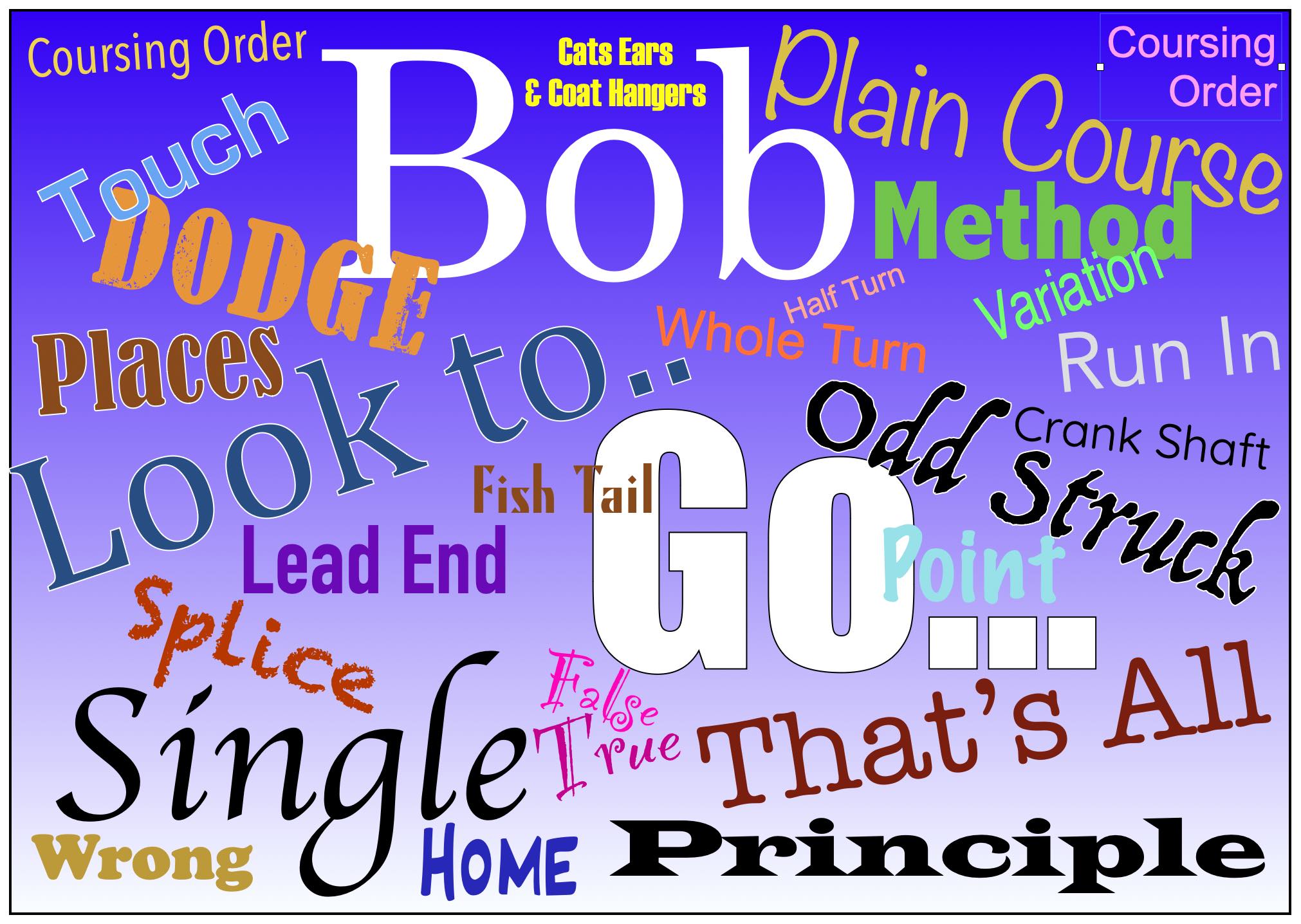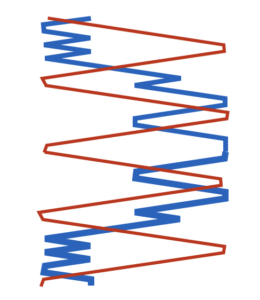Like so many specialists groups, ringers have their own language… It’s Bell Ringing Jargon – and there is lots of it!
Do you speak ‘Ringlish’? …and if so, how good is your comprehension?
If you are struggling to stay ahead… this easy to use guide will help you to keep up with all those terms you are not quite sure about and the obsessives who do not seem able to converse in anything else….!
Search by Letter...
A
Alliance Method
An Alliance Method has a treble which follows a more complex pattern than plain hunt, but is not treble bob hunt. It is not symmetrical from front to back. Common versions include dodging at the back but nowhere else, or missing the first and/or second dodges.

B
Back
Euphemism for ringing a sequence of changes in and around the last two positions of a change.
Back Stroke
Second stroke in change ringing. This is when the ringer will pull the already ascended rope back down, using the tail end of the rope.
Balance
Point at which the upside down bell is perched perfectly and does not fall. A good ringer will get their bell to the balance at every stroke, allowing them to control the bell with minimal effort.
Belfry
See Bell Chamber.
Bell Chamber
The space at the top of the tower where the bells are found. Can also be called a Belfry.
Bob Course
A Bob Course is a touch which contains consecutive Bobs at every lead end. Generally used to practice bobs , it will normally be no longer than a plain course.
C
Cambridge Places
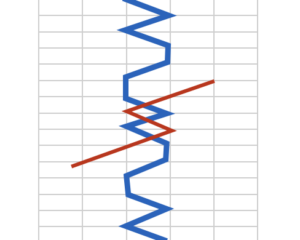
Call
The conductor will shout, ‘bob‘ or ‘single‘ instructing ringers to take action in order to create a touch. Calls are placed at strategic points… normally as the treble arrives back at lead and cause some of the bells to be switched, thus creating different patterns of changes. In spliced ringing, the calls will also be used to change from one method to another, in which case the calls will be at the treble’s back stroke lead.
Caters
Caters is the name given to the 9-bell stage. All 9-bell methods carry a name followed by Caters. e.g. Pebworth Bob Caters.
Cats Ears
Cats Ears is a colloquial description of the work the bell moving to the back performs when a ‘single’ is called in Stedman Doubles. It is the inverse of ‘Coat Hangers’.

Change
A Change is a re-ordering of the bells, created by swapping adjacent bells in the order. In change ringing, this occurs every time the bells strike… so a change is generally considered as the smallest unit measurement.
Cinques
Clapper
Large hinged metal shaft with a ball and flight on the end, which swings inside the bell to hit the front and back sides of the bell as it swings.
Composer
Conductor
Course
A Course is a measure of length in method ringing. It refers to the length of the method without any extra calls. This will be related to the number of working bells and type of method. In ringing composition and conducting, courses are a simple way of calculating the length of a touch or breaking longer lengths down into sections.
D
Delight Methods
Delight is a method type which have a treble that dodges at every possible position. However, unlike Treble Bob methods, it is allowed for other bells to be static and make a place at points where the treble is hunting. Most ringers would struggle to explain this and would not easily notice the difference between the method types for treble dodging. Delight methods tend to have more static patterns of changes with blocks of changes where bells stay in or around the same place than pure Treble Bob… but less than surprise methods.
Dodge
A dodge is a device which causes a bell to change direction for 1 change. Dodges create a zigzag in the line as bells hunt to and fro. Every dodge will involve 2 bells… one which is on th way up and one which is on the way down. It is possible to put multiple dodges together, which then causes the two affected bells to oscillate back and forth.

Doubles
Doubles is the name given to the 5-bell stage. All 5-bell methods carry a name followed by doubles. e.g. St Simon’s Doubles.
Down
Process of ringing one place earlier in the subsequent changes and moving to a lower numbered position in the order… ringing 4th, 3rd, 2nd, etc.. Moving down involves ringing slightly faster.
E
Ellacombe
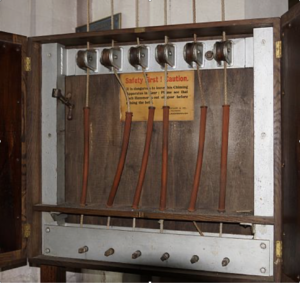
A wooden frame with tethered ropes for each bell, which will be mounted on the wall of some towers or ringing chambers. It allows one person to chime all the bells by pulling the ropes.
An Ellacombe can be used to ring tunes or changes, but the sound of the bells will be fundamentally different from full circle ringing, simply because it uses hammers on the outer side of the bell instead of swinging the bell and using a clapper.
Extent
The factorial number for the bells ringing the changes. It defines all the possible permutations and is a requirement for peals and quarter peals on lower numbers of bells.
F
False
When ringing a touch, it is expected that no changes are repeated. A touch which includes repeated changes will be classed as ‘false’ and will be disallowed if it is part of a peal or quarter peal.
Falseness
Falseness is a category that can be applied to methods to help composers and conductors to group methods for splicing purposes. Methods in the same falseness group can be spliced much more easily. Compositions using splices, may not specify a method… only a falseness group, allowing the conductor flexibility in choosing the methods to be included.
Fish Tail
Colloquial description of 1.5 dodges. A fish tail always involves a change of direction so might be turning at the back in 6-5-6. It is generally only found in more complex and difficult methods as it causes the bell completing the move to hunt out of step or ‘wrong’ compared to the normally expected pattern.

Front
Euphemism for the leading position or ringing a sequence of changes in the first two places.
G
Go…
The term Go is used to tell the ringing team to start a method…. So ‘Go Plain Bob’ for example. A call is normally made at hand stroke, one whole pull before the intended start.
Grid
Representation of a method as a sequence of lines, where all the place bells are shown superimposed so the ringer can see how each interacts with the others.
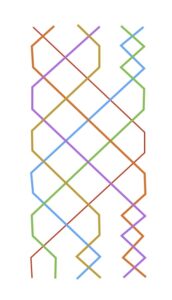
Gudgeons
Heavy duty metal spigots on the headstock, which mate with the bearings to provide the turning mechanism for the bells.
H
Half-Lead
In method ringing, the half lead is the point at which the treble reaches the back. This is also a symmetry point of the method grid. The treble will ring the reverse pattern in the second half-lead, as it returns to the front and the lead end.
Half Turn
Term used to describe part of the Stedman principle. There are two Half Turns in the Stedman slow work which intersect the Whole Turns. A Half Turn consists of a point lead with two blows in thirds before and after.

Hand Stroke
First stroke of a bell when the ringer pulls the Sally and the rope then rises up towards the roof.
Harmonic
Scientific term which describes a frequency contained within a sound that helps give it a characteristic sound. In tuned instruments, most harmonics will be whole multiples of each other starting with the first or fundamental which is the note we actually perceive. Bells have five very prominent harmonics (as well as many less prominent ones) which are tuned to create what is considered to be a well balanced and desirable sound.
Headstock
Large piece of steel or wood which the bell is mounted on to and which acts as an axle for the bell when swinging.
Home
Calling position in method ringing… which will coincide with a lead end. The home position is when the biggest bell is working at the back and the right way around for it to be possible to come into rounds at back stroke.
Hum
Hunt
Process of sequentially moving from place to place in the changes. You can hunt up or down, by decreasing or increasing the ringing speed of the bell with respect to the other bells.
I
In
Conducting term, used to describe the calling position in which the conductors bells will move to the front position, become 2nds place bell and leads.
Internal Falseness
Composers will generally check a method is true by looking at the lead end changes. However, if singles are added or methods are spliced, some more complex methods will repeat changes within the internal body of the method. Internal falseness describes this phenomena and falseness categories will help composers and conductors work out which methods can be combined. See Falseness.
J
K
L
Lead
Process of ringing first in a change. This is generally done for two blows…. hand stroke and back stroke. Some methods may require bells to lead the other way around… often referred to as leading ‘wrong’. The idea behind leading for two blows is that the first blow allows the previous bell to leave and the second allows a different bells to move up to lead next.
Lead End
In method ringing, the treble is a reference bell which hunts or rings a much simplified line. A lead end is the point at which the treble repeats. Most methods will have one lead end for each working bell… provided no one adds any extra calls to further muddle the pattern.
Lie
Process of ringing last in a change. Like leading, it generally involves being last for two blows, to allow the previous bell to escape and the next bell to move up ready to take over. In odd bell methods a lie is normally back and hand stroke, however for even bell methods it will be hand and back stroke. Occasionally, this will be reversed, in which case it will be considered to be ‘wrong’.
Look to…
M
Major
Major is the name given to the 8-bell stage. All 8-bell methods carry a name followed by Major. e.g. Little Bob Major.
Making the Bob
Phrase used to describe the bell that makes 4ths at a Bob. This generally involves hunting out from the front and then symmetrically reversing after making 4ths…. however, a handful of methods involve making the bob from behind…. Reverse Canterbury Pleasure and London Surprise, being the best known examples.
Maximus
Maximus is the name given to the 12-bell stage. All 12-bell methods carry a name followed by Maximus. e.g. Yorkshire Surprise Maximus.
Method
Repeating rhythmic sequence where all but one of the bells ring the same pattern, but start at different places in the sequence. Very much like a musical round e.g. London’s Burning’. The remaining bell in a method (normally the treble), will ring a shorter repeating sequences called ‘leads’. Method will run for ’n’ leads where ’n’ is the number of working bells. Sequences can then be lengthened to create touches by the addition of Bobs and Singles.
Minimus
Minimus is the name given to the 4-bell stage. All 4-bell methods carry a name followed by minimus. e.g. Plain Bob Minimus.
Minor
Minor is the name given to the 6-bell stage. All 6-bell methods carry a name followed by Minor. e.g. Double Oxford Bob Minor.
Muffle
Cup shaped leather pad which can be strapped to a clapper to mute the sound the bell makes at hand stroke and/or back stroke. It its normal to half muffle the bells for sad occasions such as Remembrance Sunday and some funerals. Half muffled bells ring alternately loudly and then softly… almost as an echo.
N
Nominal
One of the most important harmonics in bell tuning. The Nominal will be particularly prominent in the initial transient strike note of the bell. It equates to the 4th harmonic of the natural harmonic series.
O
Observation Bell
A Bell which is largely unaffected in a touch and only rings plain courses. This is an ideal bell for a conductor to ring and compositions are normally written from the point of view of the ringer of this bell.
Odd Struck
Bell which does not strike consistently between hand and back strokes, or exhibits different timing from the other bells in the tower.
P
Palindrome
A symmetrical structure. Most methods are palindromes in that not only the treble will do the same work on the way out and the return of each lead, but the main blue line is also symmetrical about both the start and mid point. As an example, in a five lead method, starting at the lead end symmetry point, the first and second leads will be symmetrical with the 4th and last leads and the 3rd (middle lead) will be symmetrical about the half lead mid point.
Peal
Touch of 5040 continuous changes, rung as a set piece and as a major event… often for special occasions. It takes 2.5-3.5 hours to complete. For higher numbers where 5040 has no significance, anything over 5000 is considered to be a peal. A peal must contain no repeated changes… or for lower numbers… equal numbers of every possible change.
Place Bell
Subsections of a blue line which show where each bell starts in the canonic structure of the method. Each place bell will run for one lead end . Place bells are essential to ringers to help break down long lines, to know where to start depending on which bell they are and know what to do when changing method or splicing.
Place Notation
Efficient coding system for describing a method, by listing which bells do not move in each row. Because of the palindromic nature of methods and the repeating leads, most methods can be described in place notation using only a handful of numbers.
Places
When a place is made, a bell will pause for 1 blow before continuing on. More often than not, this will occur in pairs, which will be the equivalent (and inverse) of a dodge.

Plain Hunt
Simplest form of change ringing, where alternate pairs of bells are switched in each row… providing a short sequence of changes which is twice the length of the number of bells ringing…. i.e. 10 for doubles, 12 for minor, etc. Plain Hunt is normally the first step in learning how to ring changes. Adding calls to Plain Hunt, it becomes known as a principle called Original.
Point
Point describes an instantaneous change of direction. This involves only spending one blow in a position before reversing. Points generally only occur in more complex and difficult methods as it causes the bell completing the move to hunt out of step or ‘wrong’ compared to the normally expected pattern… as a result, the bell will arrive at lead at back stroke.

Prime
Principle
A principle is like a method, but with only working bells. Because all bells are included, conducting is much harder as there are no obvious reference points or signposts to help ringers stay in time and rhythm. Probably the best known principle is Stedman… which is notoriously difficult to both ring and conduct… generally, when it goes wrong, it will be terminal for that performance!
Pub
Place where ringers are found when not in the ringing chamber!
Q
Quarter Peal
A Quarter Peal is a minimum of 1260 continuous changes. It is rung for special services and events. A Quarter Peal is generally seen as the first major benchmark in change ringing as it involves 35-55 minutes of ringing without pause. Like a peal, it cannot contain repeated changes unless all the permutations have already been used.
Quint
R
Ringing Chamber
Where the bell ringers are found! It will normally be one or two floors below the bell chamber and acoustically insulated from the bells to reduce the sound levels to a safe and workable level. Some churches may have no specific ringing chamber, with ringing occurring in the body of the church, the church porch or ante-room.
Royal
Royal is the name given to the 10-bell stage. All 10-bell methods carry a name followed by Royal. e.g. Kent Treble Bob Royal.
Run In
Term used to describe a bell that hunts down to become 2nd place bell and leads after a Bob is called.
Run Out
A term used to describe the bell which is leading immediately prior to a Bob and which hunts out to become 3rd place bell.
S
Sally
Wooly handhold which is a found about 2 meters from the end of the rope. At hand stroke the Sally should be about 5 feet off the floor, allowing the ringer to grip it mid way up. After pulling the bell over the balance, the ringer will let go and allow the Sally to move up to ceiling. Traditionally, Sallys are diagonally striped red, white, blue, but can also be made in any combination of 1 two or 3 colours.

Set
Process used to stop a bell ringing. This is traditionally done at hand stroke, but can also be done at back stroke. The bell will be pulled slightly harder, to make sure that it passes the balance point and then stops as the stay engages with the slider preventing it from turning further.
Slider
Curved piece of wood which engages with the Stay to stop the bell from passing too far beyond the balance point when upside down.
Slow Bell
Bell which is not the treble, but which is not fully participating in the ‘inside’ work of the method either. This may be due it being a temporary hunt bell (as in double hunt methods like Grandsire) or because it is doing front work for an entire lead, before returning to the main body of work (as in Kent Treble Bob).
Slow Work
Slow Work is the long front work in Stedman where the bell will be working at the front 3 places for 30 changes. As opposed to Quick Bell where the bell hunts in and back out in 6 changes.
Sound Control
Process of managing the sound the bells make. This might involve insulation between ringers and bells, louvres to allow sound out of the tower, other acoustic devices to get a good sound balance where bells are mounted on multiple levels, and mechanisms to allow more or less sound from the louvres in densely populate areas where bell noise might be considered a nuisance.
Splice (methods)
A splice is where one method is joined to another without the bells getting back to rounds. The most advanced method ringers will come up with enormously complex splices in peals and quarter peals. Perhaps the most common splicing arrangement, (and a top benchmark of ringing ability) is ‘8-spliced’… where 8 standard surprise methods are spliced together. This can be anything from 8 leads (one for each method) to a peal.
Splice (ropes)
Splices join lengths of rope. A long splice is most commonly used as it does not really affect the thickness of the rope and is therefore quite difficult to detect. However, it is generally spread over about 1m of rope. A short splice is also used, when a meter of rope would be impossible to accommodate. It can be as little as 10cm long. In modern installations, it is quite common to splice terylene synthetic rope for the upper length to hemp rope at the bottom, simply because terylene is much harder wearing and weather proof… however, natural hemp rope is much kinder to hands.
Stage
Term used to define the number of bells being used for change ringing. Doubles for 5, Minor 6, etc. are examples of stages.
Stand
Call given when the conductor wants the ringers to ‘set‘ their bells and stop ringing. It will normally be given one whole pull in advance, so that ringers have time to pull a little harder and get their bell over the balance point.
Stay
Stedman
Fabian Stedman is considered by many to be one of change ringing’s founding fathers. Stedman wrote two books explain the art… Tintinalogia and Campanologia in the 1660’s, and 70’s. He also developed the principle which bears his name and is still considered by many to be one of the finest (if somewhat tricky) things to ring.
Surprise Methods
Surprise methods have a treble that dodges at every possible position. However, unlike Treble Bob methods, at least one bell needs to be static (not hunting) and make a place at every point where the treble is hunting. Most ringers would struggle to explain this and would not easily notice the difference between the method types for treble dodging. Surprise methods tend to have the most static patterns of changes with large blocks of changes where bells stay in or around the same place.
T
Tail End
Loose end of the rope which the ringer will retain in their hand at all times whilst ringing. At back stroke, the tail end will be about 6 feet above the floor of the ringing chamber…. just within the reach of a ringer with up stretched arms.
Tenor
Largest, heaviest and lowest pitched bell in a ring. The tenor is particularly important as it will be the tonic note (key note) of the scale and therefore defines the key of the bells. Because of its size, the tenor will also be the slowest bell to turn, and thus it is very important in setting the pace of the ringing.
That’s All…
Call used to tell everybody to stop ringing a method. The call is normally made by the conductor as the bells come into rounds. This will normally be at back stroke.
Tierce
Treble
Smallest and highest pitched bell in a ring. It is the bells which rings first (leads) in rounds. The term ‘trebles’ is also sometimes used to refer to all the smaller bells in larger rings. In method ringing, the treble follows a simplified and shorter line, and acts a reference point for the other bells.
Treble Bob Methods
Treble Bob, describes a type of work the treble does… which can also be described as ‘Treble dodging’ to differentiate from the method type. Treble bobbing, or treble dodging involves dodging at every possible position (1-2, 3-4, etc..) The sequence of changes for these methods will be double that of plain methods as the treble will visit every position twice on the way up and again on the way back. However, Treble Bob methods are more select, as many which use treble bobbing are classed as ‘Surprise’ or ‘Delight’ methods, even though, to the untrained eye, they look similar. The specific definition for treble bob methods is that all bells must hunt at the same time as the treble hunts… so no internal places occur as the treble moves for 2-3 or from 4-5
Treble Place Methods
Another specialist category of method… In this type the treble will hunt from front to back, but then may not return all the way to lead straight away. An example might be to hunt out to the back, return to 3rds place, then to the back again, before returning to lead. These methods are very strange to ring as rules for passing the treble do not help the working bells and lead ends can be almost any length. They like Alliance or Little methods will have strange falseness and limited sets of changes. Realistically, these methods are rarely rung… and then only by very advanced bands who may use them for a specific purpose in a composition.
Triples
Triples is the name given to the 7-bell stage. All 7-bell methods carry a name followed by Triples. e.g. Erin Minor.
U
Up
Process of ringing one place later in subsequent changes and moving to a higher numbered position… 2nd, 3rd, 4th, etc.. Moving up involves ringing a little slower.
V
Variation
A variation is a doubles method where the lead end from a different method is imposed as a call. It generally involves the replacement of 3 changes, so is much larger and more significant than just a different call. As a result, the method is designated a variation and given a different name. An good example would be the three changes that are a Grandsire Single used in Plain Bob Doubles which is then called ‘April Day’. Variations are not used at any stage other than doubles.
W
Whole Turn
Term which applies to Stedman slow work. A Whole Turn involves leading for 2 blows followed by a point 2nds and then leading again. Two of the blows will be, back stroke and hand stroke and the other two, hand stroke and back stroke. There is one Whole Turn at the beginning of the slow work and another at the end. The term is then carried over to other methods where this shape is found… London and Bristol Surprise being two good examples.

Working Bell
In method ringing, a working bell (also called an inside bell) describes any bell which is following the full pattern (Blue Line) of the method.
Wrong (Conducting)
A calling position in method ringing… which will coincide with a lead end. The wrong position is when the biggest bell is working at the back, but the wrong way around for it to come into rounds at back stroke.
Wrong (Hunting)
Wrong hunting is a phenomena found is some more advanced methods where an individual place, point or fish tail has meant that the bell gets out of step and reaches each position at the opposite stroke to that which is normally expected…. For example, when leading, it is normal for this to occur hand stroke and back stroke, however, in wrong hunting, it occurs back stroke then hand stroke.
X
X
x (a cross) is used to mean a pair of bells swap positions. It is also used in place nation to denote an entire row where all the bell pairs cross.
XML (Method XML)
Extensible Markup Language (XML) is a customisable computer language which is also readable by humans. It is widely used as a basis for programming in IT systems. Common everyday variations include Microsoft Word documents (docx) and HTML on the web. Ringers have their own version called Method XML, which allows place notation and compositions to be checked for false rows by machines, thus speeding the process of composing long touches such as peals.
Y
Yorkshire Places
Figure commonly found in many surprise and delight methods which involves a pattern of dodge–places–dodge in the same position. If doubled in length, it is known as Cambridge places.

Z
Further Reading....
If you would like to see different glossaries of jargon or cannot find the information you are looking for, then the links below are a good place to start looking. Inevitably, there will be a large overlap between each, but John Harrison’s glossary is very comprehensive with nearly 900 items, the Central Council’s glossary contain’s a lot of items which are more administrative in nature and the ART glossary is specifically for handbell ringers.

